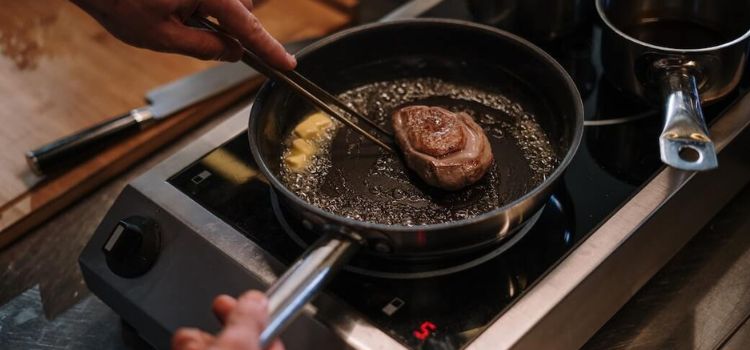As an Amazon Associate, I earn from qualifying purchases.
As an Amazon Associate, I earn from qualifying purchases
Introduction:
Cooking in contemporary kitchens has been fundamentally altered by introducing induction cookware. Induction cookware, instead of conventional cookware, is prepared to function effectively with induction cooktops through a specialised design. These cookware pieces can generate heat using electromagnetic induction because they are constructed from magnetic materials such as cast iron or stainless steel. Faster cooking times and increased energy efficiency result from this procedure, which provides precise and level heating. Professional and amateur chefs alike love induction cookware for its responsiveness and control. Even induction cooking is currently the most forward-thinking method of cooking that can be found anywhere in the world.

A Quick Overview of Induction Cookware and How It Works:
Most of the time, induction cookware uses the magnetic field that a stovetop produces to transfer heat. A pan compatible with induction cooktops works by inducing an electric current within its magnetic substance. This current eliminates the need for an external heating source by producing heat within the cookware. Hence, the cookware heats up equally and rapidly, enabling accurate temperature regulation. With this cutting-edge innovation, you can say goodbye to hotspots and hello to a uniform cooking surface.
The Key Differences Between Gas Stoves and Induction Cooktops:
Natural gas-fueled open flames are the backbone of gas stoves, allowing manual heat control and being more affordable initially. On the other hand, the induction cooktop uses electromagnetic induction to achieve exact temperature control while simultaneously reducing energy consumption and increasing safety. Magnetic cookware is necessary for them. When deciding, think about how you want to cook, how often you want to clean it, and how easy it is to install.
| Key Points | Gas Stoves | Induction Cooktops |
|---|---|---|
| Heat Source | Use an open flame produced by burning natural gas or propane | Directly heating the cookware can be accomplished by the use of electromagnetic induction. |
| Heat Control | Offer instant heat control with a visible flame that can be adjusted manually | Provide precise and instant temperature control through electromagnetic technology. |
| Energy Efficiency | This may result in heat loss as the flame heats the air around the cookware. | Are generally more energy-efficient as they directly heat the cookware. |
| Safety | Have an open flame, posing a risk of gas leaks or fire hazards. | These are considered safer as they only heat the cookware, and the surface remains cool. |
| Cookware Compatibility | Compatible with a variety of cookware materials. | For efficient heating, you need to use cookware that has a magnetic base, which is made of ferrous material. |
How do you know if your induction cookware is gas-stove-compatible?
To determine whether induction cookware is compatible with gas stoves, it is necessary to examine essential characteristics. The bottom of the pan should be flat and smooth to indicate that it may be used on either an induction or gas burner. A material must resist high temperatures and open flames to be compatible with gas stoves. Keep an eye out for the manufacturer-provided compatibility symbols; these will usually tell you if the cookware is safe to use on gas burners.
It would help if you also thought about the building material. The magnetic base is an essential component of induction-compatible cookware since it facilitates the electromagnetic induction process on induction cooktops. The magnetic base doesn’t rule out compatibility with gas stoves.
It’s best to consult the manufacturer’s instructions and guidelines for type-specific information about stoves. Try cooking on a gas burner with low heat to further guarantee compatibility and prevent damage first. Carefully inspecting these details and following the manufacturer’s instructions will allow you to confidently ascertain whether your induction cookware is gas stove compatible, guaranteeing safe and efficient use with various cooking appliances.
How to Use Induction Cookware with a Gas Stove and What to Keep in Mind:
To avoid burns and maximize cooking efficiency, think carefully before using induction cookware on a gas burner. By reading the instructions carefully, ensure the cookware is safe to use on gas burners. Generally, cookware compatible with induction and gas burners will have flat, smooth bottoms. Verify if the material is fireproof and can endure high temperatures.
Avoid scorching your induction cookware by starting on low to medium heat when using it on a gas stove. The cookware’s performance might be compromised if exposed to rapid temperature changes. If the cookware wasn’t made for use on gas stoves, you should check it for damage regularly.
To disperse any gas smells, make sure the kitchen has enough ventilation. To extend the cookware’s life, it is essential to clean it carefully after each use, considering the material’s peculiarities. Cookware manufacturers often include safety standards and advice that should always be followed.
In conclusion, induction cookware can be safely and efficiently used on gas stoves by checking compatibility, using the correct heat settings, and following maintenance and safety procedures.
Features:
- Material Compatibility: Most induction cookware is crafted from materials like stainless steel or cast iron, which are also compatible with gas stoves,
ensuring a seamless transition between cooking methods. - Heat Distribution: Induction cookware is known for its excellent heat distribution, and this feature remains valuable when used on gas stoves, preventing
hot spots and uneven cooking. - Easy Maintenance: Many induction-compatible pots and pans come with non-stick coatings or easy-to-clean surfaces, simplifying post-cooking cleanup.
- Energy Efficiency: Induction cookware retains its energy-efficient nature on gas stoves, allowing for precise temperature control and reduced cooking times.
- Versatility: Using induction cookware on a gas stove expands your cooking options, as you can adapt to various recipes and preferences without investing
in additional cookware.
Pros:
- Cost-Efficiency: There is no need to purchase new cookware if you already own induction-compatible pots and pans.
- Precise Control: Gas stoves provide fine-tuned temperature adjustments, allowing for more control over your cooking.
- Quick Heating: The combination of gas and induction cookware ensures fast heat-up times.
- Compatibility: You can switch between induction and gas cooking methods without hassle.
- Durability: Many induction cookware options are built to last, even when exposed to the open flame of a gas stove.

Cons:
- Noise: Some induction cookware may produce a humming sound when used on gas stoves due to vibrations caused by the flame.
- Weight: Cast iron induction cookware can be heavy, making it cumbersome for some users.
- Heat Retention: While induction cookware excels at distributing heat, it may not retain heat as efficiently on a gas stove.
- Cost of Induction Cookware: Initially, induction-compatible cookware can be more expensive than standard options.
- Learning Curve: Adapting to the nuances of gas stove cooking, such as flame control, may require some practise if you’re accustomed to induction.
FAQs:
- Will my current induction cookware work with a gas stovetop?
Yes, most induction cookware is compatible with gas stoves, allowing you to utilize your existing pots and pans without any issues. - How can induction cookware benefit from a gas stovetop?
Using induction cookware on a gas stove provides benefits such as cost-efficiency, precise temperature control, quick heating, versatility, and durability. - Is there any downside to using induction cookware on a gas stove?
While it’s generally feasible, some users may experience noise from vibrations, heavier weight with certain cookware types, slightly different heat retention, an initial cost, and a learning curve when switching from induction to gas cooking. - Do I need to make any adjustments when using induction cookware on a gas stove?
In most cases, no special adjustments are required. Simply place your induction-compatible cookware on the gas burner and proceed with your cooking as usual. - What should I consider when selecting induction cookware for use on a gas stove?
When choosing induction cookware for gas stove use, consider factors like material compatibility, heat distribution, ease of maintenance, energy efficiency, and your cooking preferences to ensure a seamless cooking experience.

Conclusion:
In conclusion, the compatibility of induction cookware with gas stoves offers a versatile and efficient cooking solution for home chefs. This pairing allows you
to make the most of your existing cookware collection, ensuring that your kitchen tools remain adaptable to various cooking methods.
The features of induction cookware, including material compatibility, superior heat distribution, easy maintenance, energy efficiency, and versatility,
continue to shine when used on gas stoves. This versatility opens up a world of culinary possibilities, accommodating a wide range of recipes and cooking preferences without the need for additional investment.
While the pros of using induction cookware on a gas stove, such as cost-efficiency, precise control, quick heating, compatibility, and durability, are compelling,
It’s important to be aware of the potential cons. These may include noise from vibrations, heavier weight, slightly different heat retention, initial cost considerations, and a brief adjustment period if you’re transitioning from induction to gas cooking.
In the end, the choice to use induction cookware on a gas stove offers flexibility and convenience in the kitchen, making it a viable option for those seeking a harmonious blend of modern technology and traditional cooking methods. Whether you’re searing, simmering, or sautéing, this combination empowers you to create culinary masterpieces with ease and precision.
Amazon and the Amazon logo are trademarks of Amazon.com, Inc. or its affiliates.
Leave a Reply